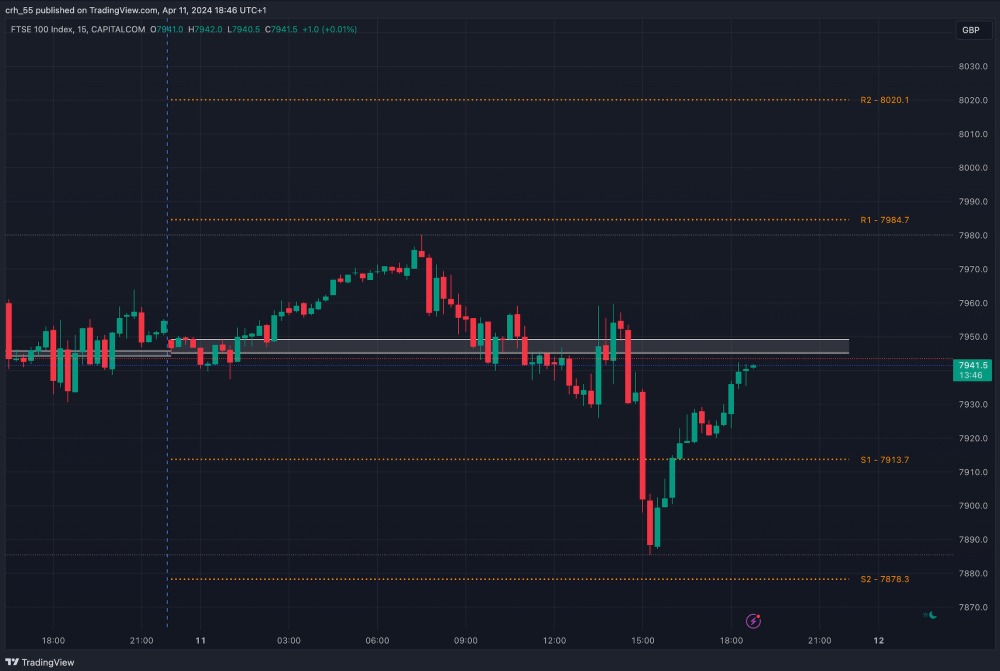Day Trading for Beginners
Discover how to start day trading in the UK through this beginner’s guide. We break down the concept of intraday trading into understandable language and offer guidance for newcomers, with information on effective short-term strategies and example trades.
Quick Introduction
- Day trading involves making trades within a single day to capitalise on short-term fluctuations in the UK stock market, for example.
- Intraday traders often use leverage (up to 1:30 under FCA rules) to amplify trading positions and potential returns, but it also increases the size of losses.
- Day trading relies heavily on technical analysis to identify opportunities, though fundamental analysis can also play a role in strategy development.
- Risk management, such as stop-loss orders and having defined risk-to-reward ratios, is critical to protect against large losses in fast-moving markets.
- Day trading is legal in the UK, but British investors should open an account with an FCA-regulated broker for the strongest account protections.
Top 3 Day Trading Platforms in the UK
-
Established in Australia in 2010, Pepperstone is a top-rated forex and CFD broker with over 400,000 clients worldwide. It offers access to 1,300+ instruments on leading platforms MT4, MT5, cTrader and TradingView, maintaining low, transparent fees. Pepperstone is also regulated by trusted authorities like the FCA, ASIC, and CySEC, ensuring a secure environment for traders at all levels.
-
Founded in 2002 in Poland, XTB now serves more than 1 million clients. The forex and CFD broker combines a heavily regulated trading environment with an extensive selection of assets and a commitment to trader satisfaction, featuring an intuitive in-house platform with superb tools to support aspiring traders.
-
Established in 1989, CMC Markets is a respected broker listed on the London Stock Exchange and authorized by several tier-one regulators, including the FCA, ASIC and CIRO. More than 1 million traders from around the world have signed up with the multi-award winning brokerage.
Best Day Trading Platforms and Brokers
What Is Day Trading?
Day trading is a strategy where you buy and sell financial instruments within the same trading day.
The goal is to profit from short-term price movements by entering and exiting trades within the hours the market is open, avoiding the risk of price gaps that can occur overnight, as well as interest charges.
This approach contrasts with long-term trading where positions may be held for weeks, months, or even years. As such, intraday trading is a fast-paced, active approach to online trading.
Brits can day trade stocks (e.g. J Sainsbury Plc), indices (e.g. FTSE 100), forex (e.g. GBP/USD), and commodities (e.g. UK Crude Oil), depending on the market’s liquidity (ease of entering and exiting trades) and volatility (price fluctuations).
Cryptocurrencies are also popular with day traders owing to their high levels of volatility. However, in 2021 the FCA banned retail trading in crypto derivatives, believing it could save up to £101 million in harm annually.
Day trading is not without risks. It requires a significant amount of knowledge, experience, and discipline. The use of leverage, while potentially increasing profits, can also lead to substantial losses.For this reason, day trading is more suitable for those with a deep understanding of the markets, a solid trading plan, and the ability to withstand financial losses.
An Example Day Trade
To help you understand how day trading works in practice, let’s walk through a trade I took on the FTSE 100 index. I used a combination of technical analysis and news trading to capitalise on a short-term movement.
Pre-Market Preparation
- Review Economic Calendar: Before the UK stock market opened at 08:00 (UTC), I checked my economic calendar for any scheduled reports or news that might affect the FTSE 100, such as inflation rates, unemployment figures, or political events in the UK.
- Analyse Overnight News: I looked for any overnight news that could influence the market’s direction. This included global economic news, as the FTSE 100 includes multinational companies whose stock prices are affected by global events.
- Technical Analysis: I performed technical analysis on the FTSE 100 chart. I used an indicator that automatically plots reference levels based on the Average True Range (ATR) from the previous day’s trading session. I also highlighted the day’s opening 15-minute price range.

FTSE 100 – TradingView
Executing The Trade
- Market Opens: When the UK stock market opened at 08:00, I watched for the initial direction of the FTSE 100 using a 15-minute chart. The first 15 to 30 minutes can be very volatile and not give a clear indication of price action.
- Entry Signal: Using a 15-minute chart, I waited for the FTSE 100’s price to close above or below the day’s opening price range that I had identified during my pre-market analysis. This would be my entry signal.
- Position Entry: I decided to go short (sell) on the FTSE 100. My entry point was as soon as the price closed below the opening price range. The price broke below the opening range and I entered a sell position at 7942.
- Setting Stop Loss & Take Profit: To manage risk, I set a stop loss at 7980, the day’s previous highest price. My take profit level was set at 7913, a price determined by the ATR.
- Monitoring The Trade: I monitored the trade and the news, and was ready to adjust my stop loss and take profit levels if the market conditions changed or if any new economic reports came out that could have affected the FTSE 100’s direction. Positive economic news (UK or US), for example, would likely have caused the index to reverse.
- Exiting The Trade: The FTSE 100 reached my take profit level at 7913 midday the same day. My position automatically closed, securing my profit of around 29 points.
- Review: At the end of the day, I reviewed my day trade to understand why it worked.
Focus on quality over quantity when selecting day trades. Instead of trying to capitalise on every market movement, concentrate on a few well-researched opportunities that will potentially lead to better outcomes.
Strategies
Day trading can become intricate, with an array of trending strategies and complex chart analyses to navigate. However, it’s important to remember that mastering everything isn’t necessary. Focusing on just one strategy and consistently applying it can be sufficient.
Here are three of the most popular day trading strategies to consider:
- Momentum Trading: This strategy involves buying securities that are moving up in price and selling them when they start to lose momentum. You’ll need to look for assets experiencing high volume and significant price movements, such as UK Crude Oil, which fell from $68 a barrel at the end of 2019 to just $14 a barrel by April 2020 due to COVID-19. It subsequently rocketed to $133 in 2022 when Russia invaded Ukraine.
- News Trading: You can capitalise on market fluctuations directly following major news announcements or economic events by predicting how an asset will respond, buying or selling based on your predictions of the short-term impact. For example, the FTSE can move in response to releases concerning British employment rates, inflation figures and political announcements, notably the 2022 mini-budget that led to huge investor concerns and a 2% slump in the UK’s chief index.
- Scalping: Scalping involves making numerous trades throughout the day to capture small price movements that add up over many trades. Scalpers typically hold positions for very short periods, from seconds to minutes. This setup works best with especially volatile stocks and currencies, for example, R&Q Insurance Holdings Ltd and the GBP/JPY pair.
Beginners might find it beneficial to concentrate on a single setup to avoid being overwhelmed, allowing them to gain a thorough understanding of specific market dynamics and strategies.More seasoned day traders might choose to diversify their trading activities across different markets and strategies to mitigate risk and capitalise on a broader range of opportunities.
Pros And Cons Of Day Trading
Pros
- By capitalising on small price movements in highly liquid stocks or currencies, such as Lloyds Bank or GBP/USD, day trading can generate profits much faster than long-term investing.
- Since positions are closed by the end of the day, you do not have to worry about the risk of significant price movements occurring overnight when you cannot manage your positions.
- Many UK day trading brokers let you use leverage, which means trading with borrowed funds to amplify profits even from small movements, though this is capped at 1:30 for retail investors.
- We’re increasingly seeing sophisticated algorithms that can automate many aspects of short-term trading, allowing for more efficient decision-making based on predefined criteria.
- Day trading can offer a high degree of flexibility, allowing you to work from anywhere with an internet connection. For some Brits, it can become a full-time profession.
Cons
- Day trading is risky because it can require making fast decisions in volatile markets. You can experience substantial losses just as quickly as gains, especially when using leverage.
- The fast-paced nature of day trading can lead to high levels of stress and emotional strain and can lead to burnout or poor decision-making driven by emotion rather than analysis.
- Successful day trading requires a significant time investment. You might need to spend hours every trading day researching, watching the markets, and executing trades.
- Day trading can incur higher costs than long-term investing due to commissions, spreads, and financing charges on leveraged positions, as well as subscription costs for market data.
- The profitability of day trading can be highly erratic, with the potential for both significant gains and losses within short periods. This can make financial planning challenging.
Bottom Line
Day trading is a high-risk, high-reward approach that requires quick decision-making, a deep understanding of market dynamics, and a strong emotional discipline to manage the stress.
While it offers the potential for quick profits without the risk of overnight market changes, it demands a significant time commitment, carries a high risk of loss, and can incur substantial costs.
Consistent profitability in day trading is not impossible, but is difficult to achieve.
Beginners interested in day trading should start by acquiring a thorough education in:
When you’re ready to begin trading with real money, see our pick of the best day trading platforms and brokers in the UK, reviewed by our active British traders and industry experts.
FAQ
Is Day Trading Suitable For Beginners?
Day trading involves a high degree of risk, fast decision-making, and the need for a thorough understanding of the markets, which can make it challenging for beginners.
It requires significant time investment to monitor the markets continuously and the ability to manage stress and withstand potential financial losses, making it more suitable for those with a solid foundation in the financial markets.
Do You Need A Large Account To Day Trade?
It’s possible to start with a smaller amount, typically up to £250 in the UK, especially in markets like forex or cryptocurrencies, which often offer higher leverage and lower account requirements.
The key is to manage risk effectively, regardless of account size, to protect and gradually grow your capital.
What Should I Look For In An Asset To Day Trade?
Theoretically, you can day trade any asset that is traded on a market with sufficient liquidity and volatility to allow for entering and exiting trades within the same trading day.
However, assets with higher liquidity and volatility are generally preferred by day traders because they offer more opportunities for profit through short-term price movements.
Is Day Trading Profitable?
Day trading can be very profitable, but it comes with significant risks. Profitability depends on the trader’s skill, strategy, discipline, and the ability to manage risk.
Ultimately, profitability may take time and not everyone is suited for the fast-paced environment of day trading.
References and Further Reading
- DayTrading.com – Caters specifically to day traders
- Do Individual Day Traders Make Money? Study from Taiwan – Brad M. Barber, Yi-Tsung Lee, Yu-Jane Liu, Terrance Odean, 2004
- The Individual Day Trader – Juhani Linnainmaa, 2005
- Day Trading 101 – Day Trade The World
- Ban on crypto derivatives – UK Financial Conduct Authority
- UK crude oil prices – Guardian
- FTSE 100 hits lows – Reuters
- Volatile UK stocks – TradingView



